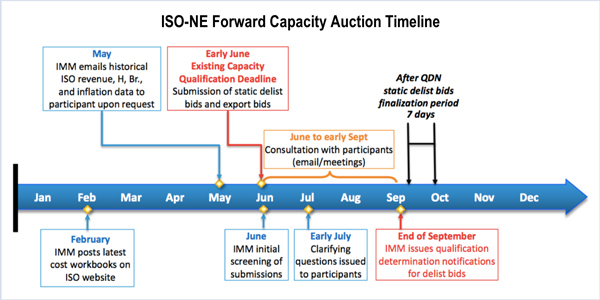By Michael Kuser
Bidders in ISO-NE’s capacity auctions would face a lower price threshold for triggering market power reviews under a Tariff revision filed by the RTO on Monday.
ISO-NE and the New England Power Pool Participants Committee filed with FERC to decrease the dynamic delist bid threshold (DDBT) in the RTO’s Forward Capacity Market from $5.50/kW-month (set in 2014) to $4.30/kW-month, starting with Forward Capacity Auction 13, slated for February 2019 (ER18-620). The DDBT is an administrative threshold established by the Internal Market Monitor for use in determining which capacity market bids from existing resources must be reviewed for the potential exercise of seller-side market power in the FCM.
The change reflects the Monitor’s estimation of the likely marginal bid in the auction. ISO-NE said changes in supply-and-demand dynamics since 2014 warrant the decrease in the DDBT. Four years ago, the Monitor projected a capacity shortage of more than 1,600 MW, but since then, existing capacity has increased each year while the installed capacity requirement has consistently declined. For next month’s FCA 12, the Monitor projects a capacity surplus of about 1,250 MW.
If the DDBT is set appropriately, bids below the threshold will be considered “infra-marginal” — that is, priced below the auction clearing price and therefore unable to exercise market power.
The Monitor aims to set the DDBT slightly below the likely competitive price from the marginal resource in the FCA to minimize the likelihood of an uncompetitive bid setting the clearing price. If the DDBT is set too high and the auction clears below the threshold, all remaining delist bids enter the auction without having been reviewed for the potential exercise of market power.
In its testimony in the filing, the Monitor explained the adverse consequences of setting the DDBT too high.
“Since the ISO makes known … the amount of remaining supply at the start of each auction round, suppliers with market power within the dynamic range of the auction may be able to profitably increase the auction clearing price to benefit their supply portfolio,” the Monitor wrote. “Furthermore, the impact of an uncompetitive increase in the auction clearing price is not localized to the individual supplier that exercises market power; the clearing price is artificially inflated for the entire capacity zone or the entire system.”
But the Monitor said there are no corresponding adverse consequences for the auction if the DDBT is set well below the price of the marginal bid.
“While doing so may result in more suppliers carrying the administrative burden of submitting delist bids for IMM review prior to the auction … this burden is not unreasonable when compared with the significant risk to the competitiveness of the auction from setting the DDBT too high,” it said.





